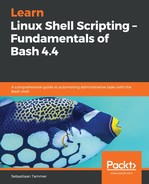This chapter explained almost everything there is to know about redirection on Linux. We began with a general description of what redirection is, and how file descriptors are used to facilitate redirections. We learned that file descriptors 0, 1, and 2 are used for stdin, stdout, and stderr, respectively.
We then got acquainted with the syntax for redirections. This included >, 2>, &>, and <, and their appending syntaxes, >>, 2>>, &>>, and <<.
We discussed a few special Linux devices, /dev/null, /dev/zero, and /dev/urandom. We showed examples of how we could use these devices to remove output, generate null bytes, and generate random data. In the advanced redirecting section, we showed that we could bind stdout to stderr and vice versa.
Furthermore, we learned about command substitution and process substitution, which allows us to use the result of a command in an argument to another command, or as a file.
Next up were pipes. Pipes are simple, but very powerful, Bash constructs, which are used to connect the stdout (and possibly stderr) of one command to the stdin of another. This allows us to chain commands, manipulating the data streams further as we go, through as many commands as we want.
We also introduced tee, which allows us to send a stream to both our Terminal and a file, a construction often used for log files.
Finally, we explained here documents and here strings. These concepts allow us to send multiline and single-line input directly from the Terminal into the stdin of other commands, something that would otherwise require an echo or cat.
The following commands were introduced in this chapter: diff, gcc, fallocate, tr, chpasswd, tee, and bc.
